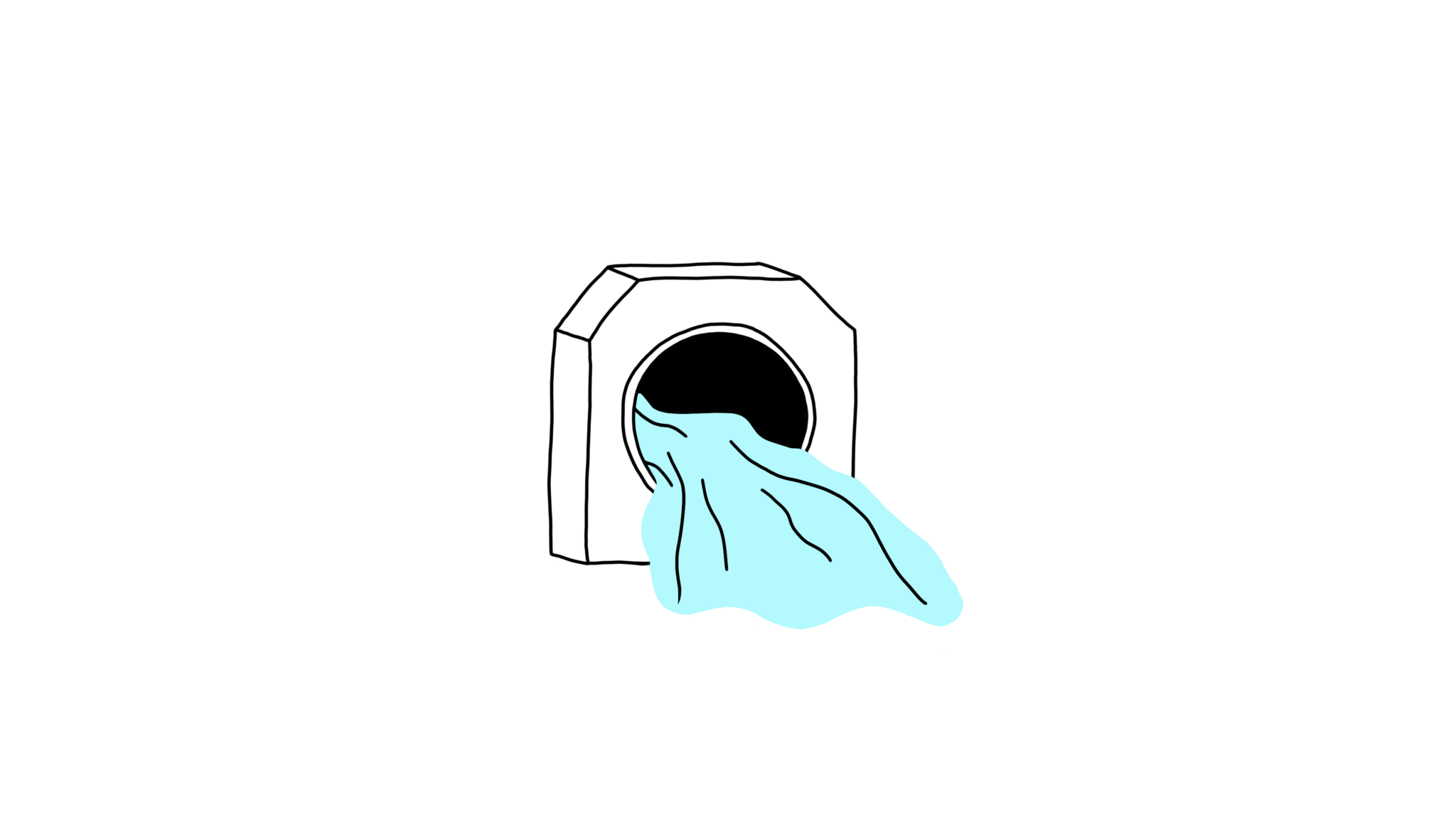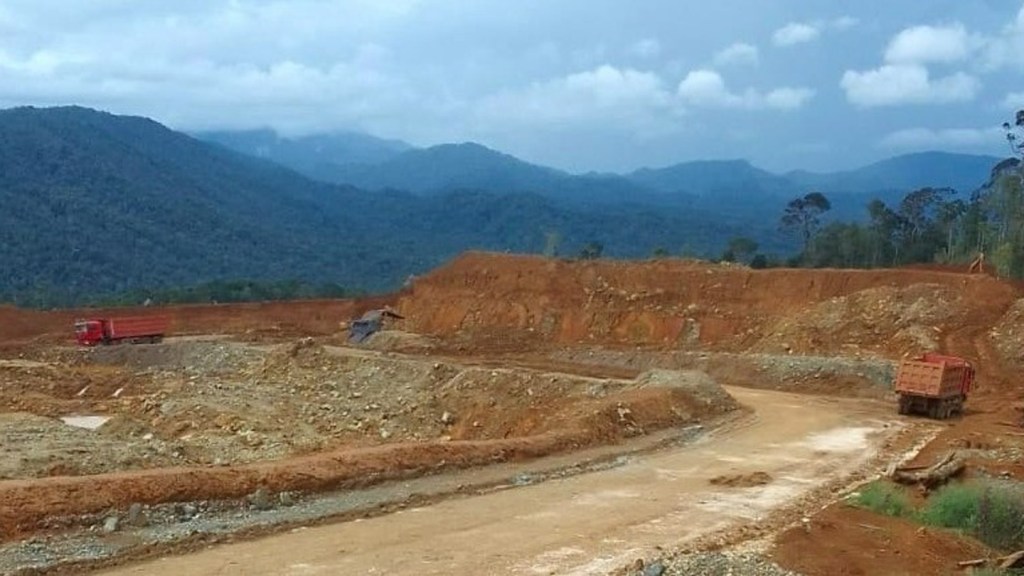Johanne Black wants to start a legend to tell future generations about the deadly arsenic in the soil and water in N’dilo, a Dene community of 200 people in the Northwest Territories.
She calls it: “The Monster Underground.”
Videos by VICE
When the Giant Gold Mine opened across Great Slave Lake in 1948, nobody warned the locals that the mine was using an especially deadly form of arsenic that dissolved easily in water. Not long after the mine opened, it emitted arsenic into the air and it settled into the snow that the children played in. English newspapers warned of contamination, but most Dene people couldn’t read these warnings. People became sick, and according to oral evidence from elder Therese Sangris, in the spring of 1951 four children died.
The details of the event are recounted in a report to the federal government, based on evidence given by local elders.
Today, arsenic levels in N’dilo’s soil are still high enough to cause long term health effects, and arsenic levels near the school and some homes are more than three times the maximum level allowed for industrial land use, according to a toxicology report obtained by VICE News through access to information.
The mine had been storing 237,000 tonnes of arsenic waste in chambers underground, where it threatened disaster for decades. While the federal government is starting to remediate the Giant Mine site, neither the Northwest Territories government nor the federal government have committed to cleaning up N’dilo or compensating its people for the mine’s effects.
N’dilo’s story may sound extreme, but they are not alone.
In June, VICE News began looking for cases of pollution affecting First Nations after Grassy Narrows finally convinced Ontario to clean up a river system that, in the 1960s, had been contaminated with mercury dumped by a pulp and paper mill. That had poisoned the fish and, in turn, the people who ate them. It took decades of public pressure for Ontario to commit funding for the cleanup — even after a former worker came forward to say he had buried barrels of mercury in the area.
According to a database run by the federal government, there are 335 First Nations like N’dilo and Grassy Narrows — cases where industry has polluted the water and soil on reserve lands. That’s more than half of all the First Nations in Canada.
The real number, however, is likely much higher. That database does not count N’dilo’s arsenic poisoning and Grassy Narrows’s mercury problem, because even if the residents of those communities are some of those affected, the contamination occurred upstream — outside the reserve, and the federal government says, outside of its jurisdiction.
There are about 300 sites on 134 reserves that have been identified for clean-up between 2016 and 2020.
The federal government’s database identifies 1,090 active contaminated sites on those 335 First Nation reserves — “active” meaning confirmed contaminated sites that require further testing or a full cleanup. Of those, 198 sites are classified as “high priority for action,” and include soil and groundwater contamination, potentially affecting thousands. The database is part of a 15-year effort that started in 2005 with the the Federal Contaminated Sites Action Plan.
Of those 335 contaminated communities, Indigenous Affairs has committed funding to remediate a number of them. Of the more than a thousand polluted sites, about 50 were remediated between 2012 and 2016 — a drop in the bucket. There are about 300 sites on 134 reserves that have been identified for clean-up between 2016 and 2020.
First Nations reserves are not the only contaminated sites in the country. There are some 5,238 active contaminated sites across the country, including those on reserves.
The federal government defines contaminated sites as those with substances that are above background levels or exceed regulatory guidelines “and pose or are likely to pose an immediate or long term hazard to human health or the environment.”
The contamination is most often the result of past activities with environmental consequences that were poorly understood at the time, Environment Canada told VICE News. The types of contaminants range from various hydrocarbons (emitted from the coal, oil and gas industries) to metals to cancer-causing polychlorinated biphenyls (PCBs).
VICE News looked at three communities that are experiencing health effects from historic industrial pollution — N’dilo, Serpent River, and First Nations downstream from the Alberta oil sands — and where chiefs and scientists say provincial and federal governments have been dragging their feet for decades.
VICE News Canada is spending this week focusing on the Indigenous water crisis. Read more here.
N’dilo
During the Great Depression in the 1930s, prospectors headed north in search of gold. Elders say the gold rush in Yellowknife began when a prospector spotted a lump of gold on a Dene woman’s stove and traded her a stove pipe for it without telling her the rock’s value. His “discovery” led Yellowknife to become a boom town, and its new reputation for gold led to the opening of mines including the Giant Mine in 1948.
Elders say they weren’t consulted about the mine, and weren’t told about its use of arsenic trioxide — which dissolves easily in water and is considered more toxic than other forms of arsenic. It’s also a known cause of cancer. The community says it has higher cancer rates now versus before the prospectors arrived.
Elder Muriel Betsina, 73, told VICE News the story of how two children died from arsenic poisoning. She knows the story because their mother, Rose, told her. One winter not long after the mine opened, two boys of about six or seven were playing outside, sliding down the snowbanks. While they played, the children ate the snow. Their mother cooked a caribou stew but when the boys came in for dinner, they complained their stomachs were sore and they couldn’t eat. Their mother looked outside and saw the snow was yellow-brown. She took the boys to the hospital.

“The same evening, they died,” Muriel said.
Johanne Black says, in one case, the parents of a child who died from eating contaminated snow were given just $750 in compensation — a fact confirmed by a letter, held by Library and Archives Canada, from the general manager of the mine to the territory’s administrator.
Although it closed in 2004, the mine’s toxic legacy continues. The upper limit of arsenic concentrations for industrial land use in Yellowknife is 340 mg/kg, according to a toxicology report obtained by VICE News through access to information. Next to N’dilo’s school, soil samples are 1020 mg/kg, and near some homes they are 1060 mg/kg, according to the same toxicology report by an engineering firm contracted by the Yellowknives Dene First Nation.
It’s unsurprising given the sheer scope of the mine’s impact. Indigenous Affairs and the territorial government co-manage the remediation of the Giant Mine site. Other than environmental monitoring, the ambitious clean-up plan includes demolishing 100 buildings, covering four tailings ponds, fencing off eight contaminated pits, treating the water that floods the underground chambers, cleaning up a creek that runs through the site, and finally, sealing the underground arsenic trioxide in frozen blocks, similar to the method used to make ice in indoor rinks.
“Right from the day that mine has been born until the last gold has been poured, it hasn’t been a good history for the Yellowknives Dene.”
VICE News asked N’dilo Chief Ernest Betsina, Muriel’s son, whether the government has done enough to clean-up the Giant Mine. He was blunt.
“No,” he said without a pause.
“Right from the day that mine has been born until the last gold has been poured, it hasn’t been a good history for the Yellowknives Dene. I’m disappointed with the whole process.”
Even Indigenous Affairs’ own monitors have echoed that disappointment, after finding its own team failed to comply with permits, CBC reported.
The chief said Indigenous Affairs has acknowledged N’dilo’s request for compensation, but hasn’t given them an answer yet. Asked by VICE News whether it would commit to compensation, Indigenous Affairs made no such commitment, saying only that the municipal and federal governments had met with Indigenous groups to hear their concerns.
The territorial and federal governments told VICE News they want to take a “proactive approach” to pollution outside the Giant Mine remediation site, including in N’dilo — but so far they haven’t done anything more than monitor that pollution.
This fall, University of Ottawa researchers will begin a human health study of the residents of N’dilo, the nearby Dene community of Dettah, and Yellowknife.
The Athabasca Chipewyan and Mikisew Cree First Nations
“I hope I’m not the next one to get cancer,” Alice Rigney says over the phone from northern Alberta.
Rigney has already overcome breast cancer, and her nephew was recently diagnosed with a rare soft tissue cancer. It seems everyone in her community downstream from the Athabasca Oil Sands has a cancer story.
The Athabasca Chipewyan and Mikisew Cree First Nations sit down the river from Alberta’s oil sands. In recent decades, residents told scientists at the Universities of Manitoba and Saskatchewan they had noticed a change in the water in the rivers and lakes. According to their observations, published in a 2014 study, new foam is washing ashore that they didn’t see before and believe is pollution. The lake water used to be clear, but now it’s so murky you can’t see below the surface.
“We call Lake Athabasca the toilet bowl of Fort Mac,” Rigney says.
Due to hydroelectric dams upstream and climate change eating away at the snow pack on the mountains, many lakes have dried up, and prized muskrat that once thrived in the region have almost disappeared since the 1980s. The blueberry patches are no longer accessible by boat because of the low water levels. Ducks and birds aren’t flocking in the numbers they used to. Locals regularly catch fish with deformities and tumours on them.
And residents say their own cancer rates are skyrocketing.
They blame the Alberta oil sands.

In 1967, the Athabasca Oil Sands opened, bringing economic prosperity to Alberta and Canada. But they have also wreaked environmental damage. Of particular concern to the First Nations downstream, three large spills in 1970, 1982 and 2013 poured oil and “coal slurry” into the Athabasca River.
In 1968, the WAC Bennett Dam was constructed on the Peace River, flooding a swath of land and releasing methylmercury from the vegetation into the river system. Methylmercury is an organic form of mercury found in vegetation like trees, bushes and soil, and it breaks down when submerged in water. It then accumulates in the food chain, including in fish, and if humans consume too much it can cause mercury poisoning, which is responsible for birth defects, neurological problems and learning disabilities.
Mercury downstream from the oilsands has accumulated in the fish and bird eggs to the point that the government has previously issued consumption warnings against eating too many of them
Researchers from the Universities of Manitoba and Saskatchewan combined western science and traditional Indigenous knowledge to test wildlife and people for contaminants associated with the oil sands. For the first time, their 2014 study showed that upstream development and environmental decline are affecting cancer occurrence in First Nations people downstream. They found that cancer rates increased in people who worked in the oil sands, and people who consumed traditionally-caught wildlife and fish.
The researchers tested 94 residents of the two nations and found that 20 had experienced 23 cases of cancer, especially respiratory, gastrointestinal, reproductive, and kidney cancers: 21 percent of the study participants. For comparison, Edmonton has an invasive cancer rate of just half a percent, according to Statistics Canada.
The study is not necessarily conclusive. Because participants were not randomly selected, the high rate may be a result of a self-selection bias. However, both the authors and the community say the study does underscore the need for additional research.
“We’ve been screaming for a health study to be done [by the province] …and still we have never received that,” Rigney says.
Those heavy metal and PAH levels are consistent with impacts upstream from the oilsands, the 2014 report asserts.
As a mother, she says she had to choose between feeding her children traditional wild-caught foods, which could cause cancer, or feeding them expensive, processed, sugary food from the Northern Store (the local grocery store), which could cause diabetes.
Levels of arsenic, cadmium, mercury, and selenium are elevated in the tissue of traditional food sources including beavers, moose and duck — high enough to be of concern to children and adults. The levels of PAHs (polycyclic aromatic hydrocarbons) were “very high” in these traditional food sources compared to other food studies conducted around the world. PAHs, which occur in nature in low levels and can also be released from industrial development, are listed on Environment Canada’s list of toxic substances, as they “may constitute a danger in Canada to human life or health.” The American Environmental Protection Agency reports that higher levels of PAHs could cause cancer.
Those heavy metal and PAH levels are consistent with impacts upstream from the oilsands, the 2014 report asserts.
The report’s findings were strong enough to prompt a response from then-MLA Rachel Notley in 2014, who is now the provincial premier: “What this report shows is that the reports that preceded have not asked the right questions, are not looking at the right things, and therefore they’re shielding the government from taking the responsibility that they need to take.”
Stephane McLachlan expected the Notley government, elected in 2015, to follow his research with a larger health study, but says there has been “no movement at all” from Alberta.
“It’s funny how these things change and the messages change when you yourself become the person in a position of influence,” the University of Manitoba researcher told VICE News.
McLachlan said the community had been calling for a government health response for more than a decade. If similar research had found a link between cancer and the oil sands in a wealthy community, he says, “there would have been a rapid, systematic response.”
A spokesperson for Alberta’s minister of environment and parks said the province has committed to working with Fort Chipewyan to develop a human health and cancer action plan — but the action plan hasn’t been crafted yet.

The province launched an Indigenous Wisdom Advisory Panel last year to advise the province on traditional knowledge and monitoring of the oil sands. The Alberta government insists it is working with Indigenous communities to improve air quality and study the overall effects of the oilsands. The province’s environmental department, meanwhile, has set up a program that absolves companies of legal liability if they clean up contaminated sites.
In March 2014, Alberta’s Chief Medical Officer of Health shared numbers regarding cancer occurrence with Fort Chipewyan, finding there were 81 cases of cancer reported in the community, while the expected number was 79 cases. “This means the overall number of cancers is not significantly higher than expected.”
In response to the study, McLachlan said, “What Fort Chip and the other communities are calling for is comprehensive study. …This is a prevalence study, they don’t have any insight into what causes the cancer.”
He said the province’s study of cancer occurrence compared cancer rates in different postal codes, which meant they were comparing “apples to oranges.”
The premier’s office did not respond to our request for comment.
Serpent River
When Elaine Johnston was a child, she remembers the army trucks driving into her community of Serpent River.
As an exercise in the 1960s, the Canadian army blew up the sulphuric acid plant on the reserve that had been built to serve the booming uranium mines in nearby Elliot Lake.
A river connects historic uranium mining sites in Elliot Lake to Serpent River, and the water dumps into Lake Huron.
Uranium mining has been blamed for thousands of deaths due to lung cancer in its workers who inhaled uranium dust. Between 1954 and 2007, there were 2,809 cancer deaths in Elliot Lake — 1,246 of those were lung cancer.
Johnston’s uncle, who worked in Elliot Lake, was one of those who passed away from lung cancer.
Johnston, now chief of Serpent River, says the demolition of the acid plant spread waste across her community. Even after the army exercise, she remembers children playing in the debris. On the powwow grounds, there was orange-brown material in the soil that would eat through their moccasins and burn the skin on their feet. In the 1980s, research by Dr. Rosalie Bertell found elevated rates of fetal deaths and abnormal births for those who worked at the acid plant.

Finally in the late 1980s, the federal government dug up material from the acid plant site and moved it to a landfill, replacing the contaminated soil with clean fill. In the 2008 fiscal year, INAC spent $317,000 on additional site restoration. But Johnston says the clean-up hasn’t been a success — the orange-brown acid is “popping back up” out of the ground.
Even today, locals say they experience high rates of cancer and respiratory problems.
Johnston wants further study of the soil and human health to see whether the historic acid plant and uranium mining pose ongoing dangers to her community.
“The running joke, even though it’s not that funny, is that we glow in the dark because of that,” Johnston said.
“How many breathed it in because it was blowing in the wind?”
Johnston says Indigenous Affairs has given Serpent River funding to study soil and water samples to see if there are potential human health impacts, but the study hasn’t started yet. Meanwhile, community members are calling for more direct study of what they say are ongoing health problems, including cancer, respiratory problems, and possible kidney issues. The chief wants resources to study the issue, a full cleanup of the site, and collect blood and hair sample for analysis to confirm suspected human health impacts.
“Have we checked the site enough to see where it might have landed?” she asked about the pollutants from the acid plant. “How many breathed it in because it was blowing in the wind?”
Indigenous Affairs said it had encouraged the First Nation to apply to Health Canada’s First Nations Environmental Contaminants Program for funding for a human health study.
The Canadian Nuclear Safety Commission, the lead agency for uranium mining and decommissioning, says all the uranium mining and milling sites at Elliot Lake have been sealed. Long-term monitoring and water treatment of these sites are underway and are expected to last for at least the next 200 years.
The safety commission confirmed all the Elliot Lake sites discharge into the Serpent River watershed and Lake Huron. However, it says monitoring programs of surface water, sediment and sand have found radioactivity levels were below federal and provincial drinking water quality guidelines, and “no health impacts are expected as a result of exposure to the water sampled.” Overall, the commission said water quality is improving around Elliot Lake.
But the commission doesn’t have regulatory oversight of the Serpent River acid plant remediation — that duty falls to Indigenous Affairs.
The Indigenous Affairs department says it is still working with the First Nation on that, and is now developing another clean-up strategy that they hope will work this time.
The department says compensation for the residents of Serpent River for the effects of historic pollution “may be the subject of future discussions.”
Conclusion
Kaitlyn Mitchell knows all about the pitfalls of trying to force government action on industrial pollution.
The Ecojustice lawyer has been working for the last eight years to get the Ontario government to act in the case of Aamjiwnaang, a First Nation that sits in what’s known as the Chemical Valley, the site of 40 percent of Canada’s petrochemical industry and where First Nations residents have respiratory issues and a two-to-one female to male birth rate due to the the heavy presence of hazardous chemicals in the air.
In February 2009, Canada’s largest environmental law charity, Ecojustice, filed an application for review on behalf of two members of Aamjiwnaang, asking Ontario to regulate the petrochemical industry by looking at cumulative effects of air pollution during its permitting process. If you’re not looking at cumulative effects, “it’s basically like putting blinders on,” Mitchell said.
The provincial government has made commitments to review its permitting process and improve its sulphur dioxide standard, but it never did.
Over the last eight years, EcoJustice has filed several lawsuits trying to force the government to act.
This year, the government still hadn’t budged, so on July 4, EcoJustice launched another lawsuit “challenging the ongoing failure of the Minister of Environment and Climate Change to comply with his legal duties.” To date, those standards have not improved.
“Eight years is far too long to wait,” Mitchell said.
“At times, frankly, there has been a lack of political will,” Mitchell said when asked to explain Ontario’s foot-dragging. She also pointed to industry pushback: Upgrading equipment to meet higher standards is costly.
Asked about the bigger picture of pollution affecting First Nations across the country, Mitchell said provincial and territorial governments along with the federal government can’t just pass the buck — they have a duty to uphold certain rights, and if they don’t, they could be faced with lawsuits like the one in Aamjiwnaang.




